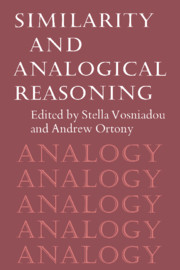Book contents
- Frontmatter
- Contents
- Preface
- List of contributors
- Similarity and analogical reasoning: a synthesis
- Part I Similarity and the structure of concepts
- Part II Analogical reasoning
- Part III Similarity and analogy in development, learning, and instruction
- 14 Analogical learning and transfer: What develops?
- 15 Analogical reasoning as a mechanism in knowledge acquisition: a developmental perspective
- 16 Remindings in learning and instruction
- 17 New approaches to instruction: because wisdom can't be told
- 18 Multiple analogies for complex concepts: antidotes for analogy-induced misconception in advanced knowledge acquisition
- 19 Comments on Part III: The activation and acquisition of knowledge
- Afterword: Comments on Parts I, II, and III: A framework for a theory of comparison and mapping
- Name index
- Subject index
14 - Analogical learning and transfer: What develops?
Published online by Cambridge University Press: 22 October 2009
- Frontmatter
- Contents
- Preface
- List of contributors
- Similarity and analogical reasoning: a synthesis
- Part I Similarity and the structure of concepts
- Part II Analogical reasoning
- Part III Similarity and analogy in development, learning, and instruction
- 14 Analogical learning and transfer: What develops?
- 15 Analogical reasoning as a mechanism in knowledge acquisition: a developmental perspective
- 16 Remindings in learning and instruction
- 17 New approaches to instruction: because wisdom can't be told
- 18 Multiple analogies for complex concepts: antidotes for analogy-induced misconception in advanced knowledge acquisition
- 19 Comments on Part III: The activation and acquisition of knowledge
- Afterword: Comments on Parts I, II, and III: A framework for a theory of comparison and mapping
- Name index
- Subject index
Summary
Introduction
Inductive reasoning is ubiquitous in human thinking. Children, like adults, must constantly make inferences that are not deductively valid. Predictions, generalizations, and inductive projections from known instances are all examples of inductive reasoning; all involve the transfer of the known to the unknown.
Such flexible use of knowledge is often cited as a hallmark of human intelligence. At the same time, transfer is thought to be an elusive quality. Herein lies a conundrum. How can one simultaneously hold that the existing state of knowledge profoundly affects learning and that transfer of knowledge across situations is difficult to engineer without heroic effort? Taken at face value, there is an uneasy sense of contradiction in the juxtaposition of these two widely held beliefs.
Nowhere is this juxtaposition more apparent than in discussions of children's learning. One of the more ubiquitous claims concerning young children is that they tend to acquire knowledge in such a way that it is closely tied, restricted, or welded to habitual occasions of use. Flexible application of knowledge is not thought to characterize the reasoning processes of the young (Brown, 1974, 1982; Rozin, 1976). But, whereas theories of encapsulated knowledge are widely held, so too are theories that attribute many developmental differences solely to disparities in knowledge between children, “universal novices” (Brown & DeLoache, 1978), and adults, who are comparative experts in many domains. But how can young children be prisoners of a knowledge base that they cannot access? In this chapter, I will attempt to resolve this apparent paradox by considering what is known about analogical transfer in children.
- Type
- Chapter
- Information
- Similarity and Analogical Reasoning , pp. 369 - 412Publisher: Cambridge University PressPrint publication year: 1989
- 114
- Cited by



